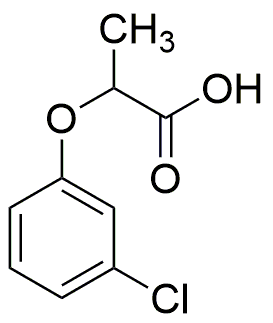2-(3-Chlorophenoxy)propionic acid is widely utilized in research focused on
- Agriculture: This compound serves as a herbicide, effectively controlling a variety of broadleaf weeds in crops, which helps farmers increase yield and reduce competition for nutrients.
- Pharmaceuticals: It is used in the synthesis of various pharmaceutical agents, contributing to the development of medications that target specific biological pathways.
- Research and Development: In laboratories, it acts as a valuable reagent for studying biochemical processes, allowing researchers to explore its effects on plant growth and metabolism.
- Environmental Science: The compound is utilized in studies assessing the impact of herbicides on ecosystems, helping scientists understand and mitigate environmental risks associated with agricultural practices.
- Chemical Manufacturing: It plays a role in the production of specialty chemicals, where its unique properties can enhance the performance of various formulations.
Informations générales
Propriétés
Sécurité et réglementation
Applications
2-(3-Chlorophenoxy)propionic acid is widely utilized in research focused on
- Agriculture: This compound serves as a herbicide, effectively controlling a variety of broadleaf weeds in crops, which helps farmers increase yield and reduce competition for nutrients.
- Pharmaceuticals: It is used in the synthesis of various pharmaceutical agents, contributing to the development of medications that target specific biological pathways.
- Research and Development: In laboratories, it acts as a valuable reagent for studying biochemical processes, allowing researchers to explore its effects on plant growth and metabolism.
- Environmental Science: The compound is utilized in studies assessing the impact of herbicides on ecosystems, helping scientists understand and mitigate environmental risks associated with agricultural practices.
- Chemical Manufacturing: It plays a role in the production of specialty chemicals, where its unique properties can enhance the performance of various formulations.
Documents
Fiches de données de sécurité (FDS)
La FDS fournit des informations de sécurité complètes sur la manipulation, le stockage et l’élimination du produit.
Spécifications du produit (PS)
Le PS fournit une description complète des propriétés du produit, notamment sa composition chimique, son état physique, sa pureté et les exigences de stockage. Il détaille également les plages de qualité acceptables et les applications prévues du produit.
Certificats d'analyse (COA)
Recherchez des certificats d'analyse (COA) en saisissant le numéro de lot du produit. Les numéros de lot et de lot se trouvent sur l'étiquette d'un produit, après les mots « Lot » ou « Lot de fabrication ».
Numéro de catalogue
Numéro de lot/série
Certificats d'origine (COO)
Ce certificat d'exploitation confirme le pays dans lequel le produit a été fabriqué, et détaille également les matériaux et composants utilisés et s'il est issu de sources naturelles, synthétiques ou autres sources spécifiques. Ce certificat peut être requis pour les douanes, le commerce et la conformité réglementaire.
Numéro de catalogue
Numéro de lot/série
Fiches de données de sécurité (FDS)
La FDS fournit des informations de sécurité complètes sur la manipulation, le stockage et l’élimination du produit.
DownloadSpécifications du produit (PS)
Le PS fournit une description complète des propriétés du produit, notamment sa composition chimique, son état physique, sa pureté et les exigences de stockage. Il détaille également les plages de qualité acceptables et les applications prévues du produit.
DownloadCertificats d'analyse (COA)
Recherchez des certificats d'analyse (COA) en saisissant le numéro de lot du produit. Les numéros de lot et de lot se trouvent sur l'étiquette d'un produit, après les mots « Lot » ou « Lot de fabrication ».
Numéro de catalogue
Numéro de lot/série
Certificats d'origine (COO)
Ce certificat d'exploitation confirme le pays dans lequel le produit a été fabriqué, et détaille également les matériaux et composants utilisés et s'il est issu de sources naturelles, synthétiques ou autres sources spécifiques. Ce certificat peut être requis pour les douanes, le commerce et la conformité réglementaire.


